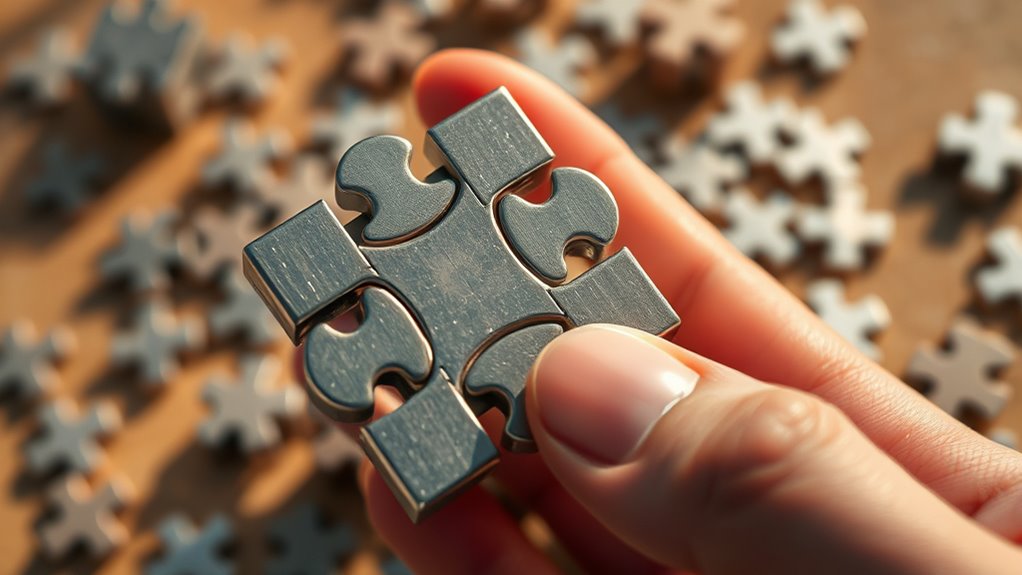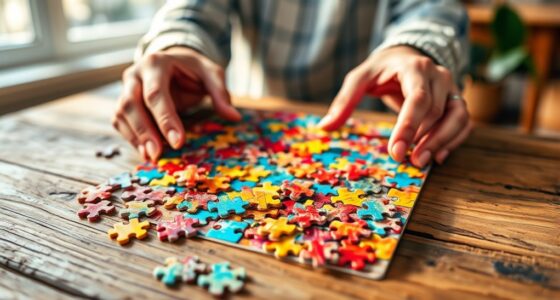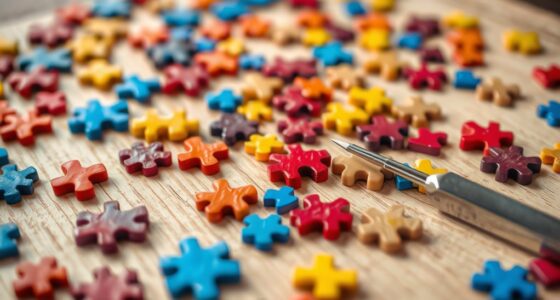To understand pattern recognition in brain teasers, focus on quickly spotting visual cues like shapes, colors, and arrangements. Your brain strengthens neural pathways through practice, making it easier to identify familiar sequences or structures. Paying attention to details such as symmetry or spatial relationships helps reveal underlying rules. With sustained effort, your recognition skills improve, allowing you to solve puzzles faster. Keep exploring, and you’ll discover more techniques to sharpen your pattern detection abilities.
Key Takeaways
- Pattern recognition enables quick identification of familiar structures, sequences, or relationships in brain teasers.
- Neural pathways strengthen with practice, improving speed and accuracy in recognizing visual cues.
- Visual cues like shapes, colors, and arrangements are vital clues for deciphering puzzle rules.
- Systematic analysis of patterns enhances understanding and anticipation of puzzle solutions.
- Consistent practice develops neural connections, making pattern detection more efficient over time.

Pattern recognition is a fundamental skill that helps you solve brain teasers efficiently. When you encounter a puzzle, your brain quickly searches for familiar structures, sequences, or relationships, allowing you to make sense of the seemingly complex information. This ability hinges on your neural pathways—networks of interconnected neurons—that become strengthened through practice and repetition. As you engage with different brain teasers, these pathways become more efficient, enabling faster identification of patterns in future challenges. Incorporating knowledge of visual cues and their significance can further enhance your pattern recognition abilities.
Pattern recognition enhances puzzle-solving by strengthening neural pathways through practice and repetition.
Visual cues play a pivotal role in how you recognize patterns. These cues could be shapes, colors, positions, or arrangements that stand out or repeat across the puzzle. Your brain is adept at processing visual information rapidly, noticing subtle similarities or differences that might not be immediately obvious. For instance, a pattern might be based on a sequence of colors, a recurring shape, or a certain spatial arrangement. By paying close attention to these visual cues, you can often infer the underlying rule governing the pattern, which is essential for solving the problem.
To improve your pattern recognition skills, focus on enhancing your ability to detect visual cues. Practice observing details in various images or puzzles, and try to identify repetitions or sequences. Over time, your neural pathways become more finely tuned, making it easier to spot patterns quickly. This process involves both honing your visual perception and strengthening the neural connections that process these cues. As a result, you’ll find yourself recognizing patterns faster and with greater accuracy, even in more complex brain teasers.
Another way to sharpen this skill is by consciously analyzing the visual cues present in each problem. Break down the pattern step-by-step, paying attention to how each element relates to the others. Does a certain shape always follow another? Are colors cycling through a specific order? Is there a symmetrical arrangement? By systematically examining these details, you develop a mental framework that helps you anticipate what comes next, increasing your confidence and efficiency in solving puzzles.
In essence, understanding pattern recognition in brain teasers involves more than just noticing superficial similarities. It requires honing your ability to interpret visual cues and strengthen the neural pathways responsible for processing these cues. With consistent practice, you’ll become more adept at quickly identifying the underlying rules, turning complex puzzles into manageable challenges. This skill not only enhances your puzzle-solving ability but also sharpens your overall cognitive functions, making you more perceptive in everyday situations where pattern recognition is key.
Frequently Asked Questions
How Does Pattern Recognition Differ Between Children and Adults?
When considering how pattern recognition differs between children and adults, you notice that children’s visual development is still maturing, which impacts their ability to identify patterns quickly. Adults, with greater cognitive flexibility, can adapt and see complex patterns more efficiently. You might find children focus on obvious features, while adults recognize subtle connections, thanks to their developed visual skills and flexible thinking. This difference highlights the evolving nature of pattern recognition across age groups.
Can Pattern Recognition Skills Be Improved Through Practice?
Yes, you can improve your pattern recognition skills through practice. By engaging in activities involving visual pattern recognition, like puzzles or matching games, and auditory recognition exercises, such as listening for patterns in sounds, you strengthen your brain’s ability to identify recurring sequences. Consistent practice enhances your speed and accuracy, allowing you to better recognize complex patterns in various situations, boosting your overall cognitive flexibility.
What Brain Regions Are Involved in Pattern Recognition?
Imagine your brain as an orchestra, with different regions playing their parts. When you recognize patterns, the visual cortex acts like the spotlight, highlighting shapes and images. Meanwhile, the prefrontal cortex functions as the conductor, coordinating thoughts and strategies. Together, these regions work harmoniously to decode patterns, helping you solve puzzles and see connections, making pattern recognition a collaborative effort within your brain’s intricate symphony.
How Does Pattern Recognition Relate to Overall Intelligence?
You might find that pattern recognition plays a key role in overall intelligence. It involves visual processing and cognitive flexibility, helping you identify connections and adapt to new information quickly. When you recognize patterns, you enhance problem-solving skills and creativity. This ability not only boosts learning but also improves decision-making, making you more efficient in complex situations. Fundamentally, strong pattern recognition skills can directly reflect and elevate your overall intellectual capacity.
Are There Common Mistakes People Make in Pattern Recognition?
Thinking about pattern recognition is like piecing together a puzzle, but you might stumble over common mistakes. You could rely too much on visual perception, ignoring subtle clues, or fall prey to cognitive biases that distort your judgment. These errors can cause you to see patterns where none exist or miss real ones. Being aware of these pitfalls helps you sharpen your skills and improve your ability to recognize meaningful patterns accurately.
Conclusion
By recognizing patterns, you sharpen your mind, boost your problem-solving skills, and unleash your full potential. By seeing connections, understanding sequences, and identifying repetitions, you train your brain to think faster and more creatively. Pattern recognition isn’t just about solving puzzles; it’s about developing a mindset that’s curious, perceptive, and adaptable. So, embrace the challenge, trust your instincts, and let pattern recognition become your secret weapon in every brain teaser you face.









